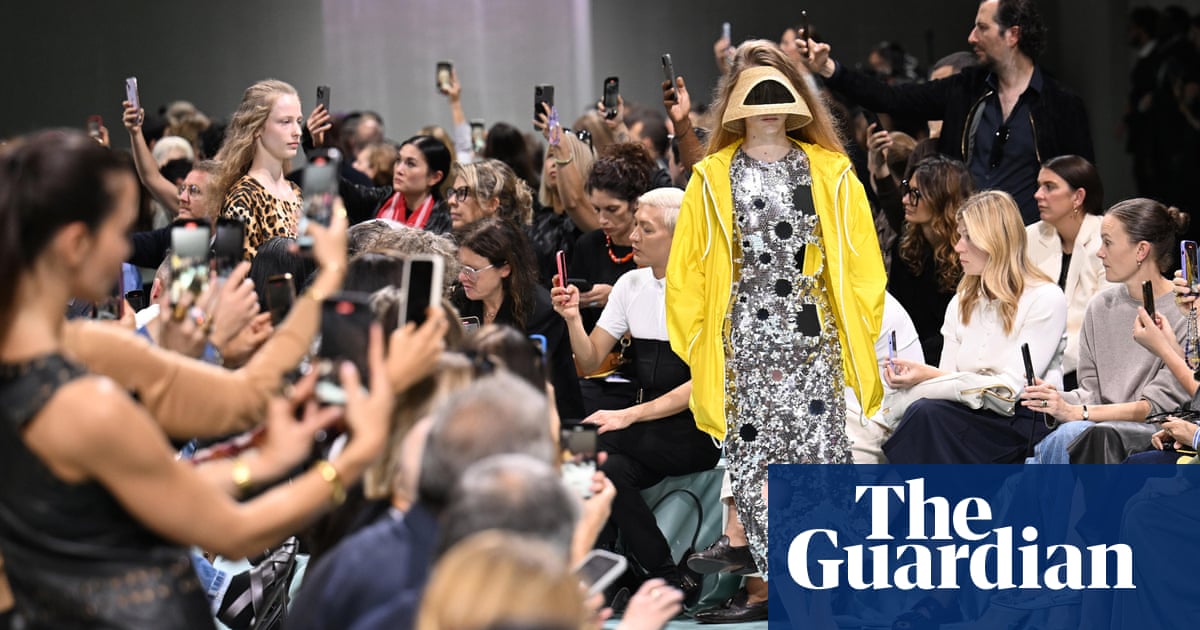A Prada show is never a straightforward beauty pageant, so when the co-designers Miuccia Prada and Raf Simons go out of their way to be contrary and challenging, the result is, frankly, pretty weird.
Thick woollen tights with belt loops. A boob tube with snap pockets on the nipples. Shoes that peel back at the heels like curls of butter. In the cavernous concrete of Prada’s Milanese headquarters, the catwalk was twisted into hairpin bends, so that the audience couldn’t see what was coming next. Each outfit was crazier than the last. A strapless lemon ballgown with sunglasses the size of a gas mask was followed by black jeans tucked into dirty white cowboy boots.
Backstage after the show, surrounded by celebrity fans queueing up for air kisses – “I’m Uma’s daughter,” said the actor Maya Hawke, when it was her turn – the designers said that unpredictability was the point. This was a rage against the algorithm. “We are driven by algorithms. We like things because people tell us to like them,” said Prada, who wanted this show to propose an alternative point of view. “We wanted every individual to be their own superhero, with their own story, their own power,” added Simons. “Not power, I don’t like power. I like strength,” corrected Prada.
The collection was bold in its unpalatability, and Prada admitted that she had been “very, very nervous for this show, much more than usual”. The collection doubled down on Prada’s oddball DNA, dotted with Easter eggs in the form of cameo appearances by cult Prada shoes, including a brogue with an espadrille sole last seen on the catwalk in September 2010. “There was an intention of showing how you can use old things,” she said.
Earlier in the day, Lessons in Chemistry, Bonnie Garmus’s bestselling book – brilliant female chemist versus the patriarchy – got Max Mara’s designer Ian Griffiths thinking about the creativity of science and the elegance of mathematics. “It’s funny, isn’t it, how creative people will often say tell you quite proudly that they can barely add up,” Griffiths said backstage after his show. He added a Kurt Vonnegut quote: “science is magic that works”.
Elegant maths is essential for elegant tailoring. A dressmaker uses precise angles to make the darts that turn a flat piece of fabric into a three-dimensional one. Those workings-out are usually hidden discreetly away, but this collection celebrated them. Angles were out and proud on the catwalk. The projection of a sharp shoulder on a tailored, chocolate-brown coat, the Pythagoras-slice of a dress triangulated by a one-shouldered neckline, the symmetry of a tightly cinched waist. Darts became design features, while creases were ironed in instead of being ironed out.
On the catwalk, the effect was beautifully simple: lots of crisp white shirts, tailoring that purred with soft power, fluid slinky dresses and the cosy camel coats that are the brand’s hero piece. The winning formula at Max Mara is clever clothes that look easy. “I love to experiment but I would never want it to look experimental on the catwalk,” Griffiths said. “I don’t think a woman spends the kind of money she spends in a Max Mara store to look like she’s part of some kind of experiment. She wants to look polished and completely in control.”

